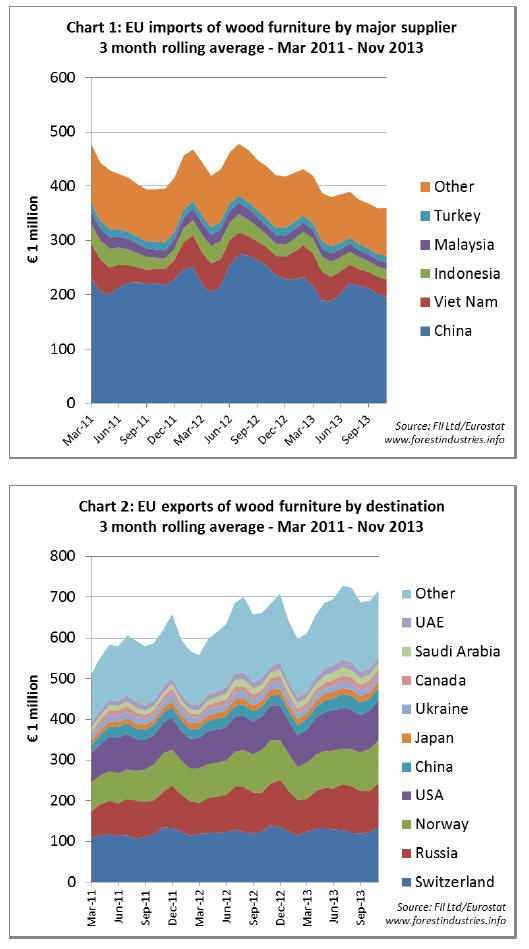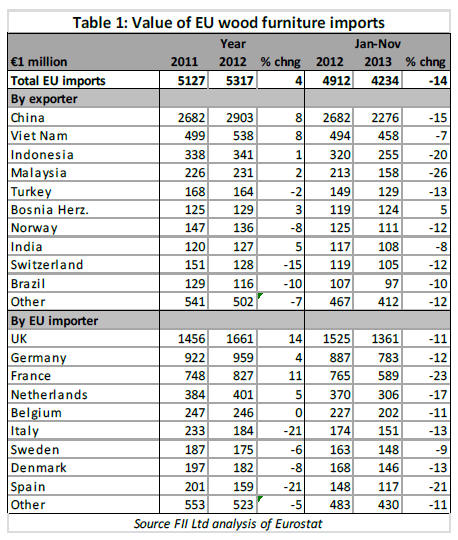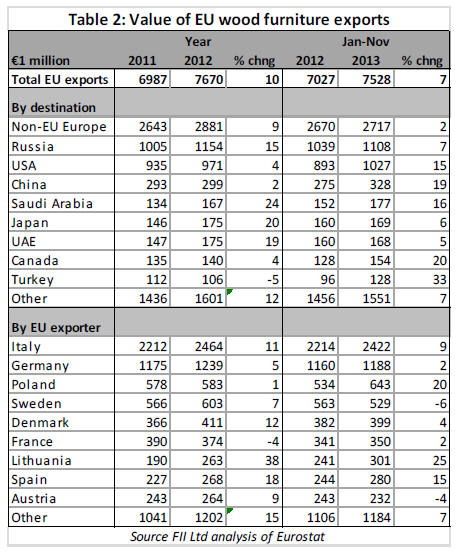|
Report from
Europe
Signs of revival in European wooden furniture
manufacturing
The recession in Europe has created many challenges for
the European wood furniture sector. However the sector
remains globally significant as a driver of design and
production innovation.
There are also signs that the international competitiveness
of the European furniture sector is improving.
The charts below suggest a significant change in Europe‟s
position in the global market for wood furniture. Chart 1
shows the 3 month rolling average value of EU imports
between the start of 2011 and November 2013.
Chart 2 below shows equivalent data on EU exports during
the same period.
The moving average is used to smooth out short-term
fluctuations, which are strongly influenced by factors like
vacations or shipping delays, so that the longer-term trend
becomes clearer.

EU imports of wood furniture have been falling over the
last 3 years (Chart 1) while exports have been rising
(Chart 2).
At the start of 2011, EU net trade in wood furniture was
close to zero, with both imports and exports averaging
close to €500 million per month. However, by the end of
2013, the EU had a trade surplus in wood furniture of
around €350 million per month.
Average monthly imports of wood furniture into the EU
had fallen to €350 million while exports had risen to just
over €700 million per month.
These figures should be put into perspective. EU external
trade in wood furniture is relatively small compared to
total consumption, which is about €50 billion per year (or
€4200 million per month). There is much reliance on
domestic manufacturers.
Only about one quarter of wood furniture consumed in EU
countries ever crosses a national boundary. Total internal
trade in wood furniture between EU countries averages
around €1200 million per month.
Trade statistics and anecdotal reports suggest that the level
of EU consumption and internal trade in wood furniture
have been static at a low level since 2009 when there was
a steep decline during the financial crises.
While external trade forms only a small part of the EU
furniture sector, it is becoming much more relevant to
European furniture manufacturers. During the recession,
manufacturers have become more focused on improving
competitiveness relative to manufacturers in other
countries, particularly China.
With consumption static in domestic markets, European
furniture companies are seeking to increase sales in other
parts of the world.
This more outward looking strategy seems to be working
for EU manufacturers. Exports of wood furniture are
rising, particularly to Russia, North America, China, and
the Middle East.
The rise in exports is being led by manufacturers in Italy,
Germany and Poland (see Table 1). Meanwhile EU
imports of wood furniture have been falling, a trend which
strengthened in 2013 and affected all the main external
suppliers including China, Viet Nam, Indonesia, Malaysia
and Turkey (see Table 2).
Overall these trends suggest a revival in the relative global
competitiveness of European wood furniture
manufacturers over the last 3 years.
 
Strong global influence of large EU furniture
manufacturers
The latest edition of World Furniture
(www.worldfurnitureonline.com), the quarterly journal of
the Italian furniture industry research association CSIL,
includes an overview of production trends in the European
furniture sector.
CSIL note that profits have declined and the total value of
European furniture production has been static for a decade
(or even decreased in some countries). However CSIL also
highlight the strong global influence of Europe.s largest
furniture companies.
Following the recent rapid growth in emerging markets,
particularly China, the EU now accounts for one quarter of
the world.s furniture production and consumption. EU
share of world furniture production has contracted over the
last decade so that the total value of production in the EU
in 2012 was no more than ten years previously.
Total EU furniture sector turnover in 2012 was ¢æ100
billion, just over the peak of 2008. European furniture
industry profits after tax and net income have reduced by a
cumulative 30% over the last 5 years.
However these trends are partly offset by a rise in
furniture production in plants operated by European
companies in other parts of the world. European furniture
companies continue to play a leading role in the
international market.
Europe is home to 84 of the world.s Top 200 furniture
manufacturers. These companies are mainly located (in
order of importance), in Germany, Italy, Sweden, France,
the UK, Poland, Finland, the Netherlands, Austria,
Denmark, Lithuania, Spain and Romania.
Although in terms of numbers, around 85% of European
furniture companies are micro enterprises with less than
10 employees, the leading European companies are very
large.
The 100 largest companies in Europe have a total turnover
of ¢æ20 billion and average of ¢æ150 million. Together these
100 companies account for around 20% of the EU
furniture sector turnover. Their productive presence now
includes numerous plants outside the EU, notably in
China, Russia, Ukraine, Belarus and USA.
Europe's large furniture companies have adopted various
strategies to improve competitive during the European
financial crises.
These include downsizing (with plant closures and layoffs),
increasing production efficiency, increased sourcing
from Asia, strong investment in existing and new retailing
formats (including in emerging markets) and a strong
focus on brand development.
As a result, despite the recession in domestic markets,
European manufacturers have retained their global
leadership in furniture design and production innovation.
European furniture manufacturers go east
CSIL report that around 80% of EU furniture production
value in 2012 was in Western Europe (EU15 group of
countries). This is down from around 90% a decade ago.
However, these figures omit the rising value of production
by Western European companies in plants outside the
region.
Weak European consumption has meant that Western
European companies now focus heavily on expansion of
exports to fast growing emerging markets.
Germany has the best performing furniture sector and
recently overtook Italy as the largest European furniture
producer (in terms of value).
Germany now ranks as the world's third largest furniture
producer after China and the United States. It is also the
second largest exporter after China. According to Eurostat
data, Germany is host to over 9,000 furniture
manufacturing companies.
The furniture sector in Italy, comprising 20,000 mainly
small furniture companies, is more fragmented than in
Germany. These companies are concentrated in several
regional clusters in Italy.
The performance of these clusters has varied widely in
recent years depending on product specialisation and their
diversity of export markets.
Rapid production growth in Poland
Production value in the EU13 group of Eastern European
countries increased 50% between 2002 and 2012. This
region now accounts for 20% of total EU production
value. Production growth has been particularly rapid in
Poland, Romania, Lithuania and Slovakia.
Furniture production in this region has always been more
export-oriented than in Western Europe. By combining
relatively cheap labour with proximity to European
customers, furniture production in these countries has
risen alongside the on-going process of EU eastern
expansion and market integration.
Poland is by far the leading furniture exporter in Eastern
Europe with over ¢æ6 billion in 2012. Exports accounted
for as much as 79% of Poland.s production value in 2012.
Poland is also increasingly influential in the global
furniture industry. In 2012, it was the world.s 7th largest
manufacturer (up from 12th in 2002) and the 4th largest
exporter (up from 5th in 2002) after China, Germany and
Italy. As in Italy, production in Poland is highly
fragmented.
There are almost 24,000 furniture manufacturers in the
country mainly concentrated in the Wielkopolskie,
Mazowieckie and Malopolskie regions.
Romania is the second largest furniture producer in the
EU13 group of countries, although production of ¢æ1.5
billion in 2012 was only a quarter of that in Poland.
Furniture production in Romania expanded at an average
annual rate of 6.3% between 2002 and 2012. Exports
account for 88% of production and have driven this rapid
growth.
The Czech Republic is the third largest producer of
furniture in the EU13, with production value of ¢æ1.4
billion in 2012. The country has around 500 producers,
mostly locally owned with lower levels of foreign
investment than in other parts of the region.
Lithuania is now the fourth largest furniture manufacturer
in Eastern Europe, with production value rising by 400%
between 2002 and 2012, notably due to large investments
by the Swedish giant Ikea.
Ikea reports strong market growth in China, Russia
and US
The 2013 financial report for the Ikea Group, the world's
largest furniture retailer, provides insights into the outlook
for the international furniture sector.
In the financial year 2013 (to 31st August 2013), Ikea's
sales increased 3.1% to ¢æ27.9 billion and profit also
increased by 3.1% to ¢æ3.3 billion. Market conditions
continued to improve, reports the retailer, with strong
growth in China, Russia and the US.
Ikea reports that "Consumer spending is improving in
many countries. While the challenging economic situation
may not be over, there are positive signs. Important
consumer markets such as the US are coming back and
Europe in general is starting to recover.
Even some of the challenging markets in Southern Europe
are showing good signs of activity.¡± The Ikea Group
claims to have gained market share in almost all markets.
The largest markets were Germany, the US, France,
Russia and Sweden. Ikea, which specialises in large
volume sales of low priced furniture, suggests "this
indicates that value for money is increasingly important".
The Ikea Group has an ambitious growth agenda, aiming
for ¢æ50billion in sales by 2020. It states that the large
emerging markets are important sources of future growth.
In FY13, the Ikea Group opened two more stores in China
. another step in expansion in the Chinese market. Ikea's
long-term focus is to "keep developing better products at
lower prices, improving the shopping experience and
becoming more accessible to our customers, for example
through an improved service offer, e-commerce and
continued expansion".
European furniture shows highlight continuing strong
fashion for oak
A recent report from the American Hardwood Export
Council (AHEC) reviews fashion trends based on visits to
European furniture shows. AHEC note that there are three
high profile furniture shows in Europe. The imm show in
Cologne, Germany and Maison Objet in Paris take place in
January, while the Salone del Mobile is held in Milan,
Italy in April.
All attract an international audience both in terms of
visitors and exhibitors. However, exhibitors often have to
choose between the Cologne and Paris as they are held
within only a few weeks of each other.
The Cologne fair is more traditional and is of particular
focus for companies selling into the German market and
other Central and Northern EU countries. But as with all
the big European shows there are always plenty of visitors
from outside Europe.
Based on their visit to imm Cologne, AHEC suggest
contemporary design furniture has a much greater
representation than in the past. Traditional and
reproduction furniture is shown but does not dominate.
The exhibition is a platform for leading brands and
individual designers targeting the higher end of the
market. As a result, quality materials are used.
There was a lot of real wood on display, often in
combination with other materials.
It is hard to quantify, but AHEC suggest that real wood
was more prominent than in previous years and there were
fewer paper foil and vinyl finishes. This suggests the
higher end of the European furniture sector is still an
important source of demand for hardwood.
According to AHEC, contrasting colours is a very obvious
trend at the moment, and many manufacturers are using
the natural tones of wood to contrast with bright colours.
White with wood also seemed a particular theme for many
brands this year.
The vast majority of the wood was temperate hardwood;
there were relatively small amounts of tropical hardwood
or softwood species on show.
The dominant species was oak, but ash was also common,
a little beech and quite a lot of walnut, most of which was
American. AHEC report that the trend for a natural rustic
look has grown in recent years. It is now common to see
leading brands offering expensive designer collections
with ¡°character¡± solid oak.
This oak contains grain and colour variations and even
sometimes knots. Most of the character oak was from
Europe. European producers are favouring European oak
because they can source short dimensions and low grades
more cheaply than white oak from the USA. For the
cleaner more consistent look, manufacturers use mostly
veneered panels for the surfaces but solid for legs, rails
and chairs.
AHEC also note that at Cologne there was quite a lot of
bent wood being used in the contemporary chair design
especially ash which lends itself to this application, but
also beech and some oak. One new trend this year was the
use of heat treated hardwoods - European and North
American - for outdoor furniture.
According to AHEC many of the wood trends apparent in
Cologne were reinforced at Maison Objet in Paris. At this
show, oak was by far the dominant wood material for both
furniture and flooring. Flooring manufacturers exhibited
oak in hundreds of different finishes and colours. Furniture
and interior fittings in pale oak were very popular and
often contrasted with other materials such as fabrics or
metals in bright colours.
The Paris show also highlighted the continued fashion for
„streamline‟ designs ¨C tables with very thin legs and backs
and tables with wafer-thin tops. For higher end products,
many manufacturers were using American walnut which
remains very popular for luxury goods. Many companies
at the show reported that their production is now based in
China, Vietnam, Poland and Romania.
Chinese products increase market share in the UK
The new Statistics Digest issued by the UK Furniture
Industry Research Association (FIRA) at the end of 2013
suggests a small recovery for furniture manufacturing in
the UK.
However the sector continues to suffer from loss of market
share to Chinese product in the domestic market and poor
export market performance. The report indicates that the
UK furniture sector manufactured £6.5 billion of product
in 2012.
The significance of imported furniture is reflected by the
fact that, at between £4.3 and £4.5 billion, it comprises
40% of the home market. UK furniture exports, however,
have remained relatively static for many years, and
struggle to reach £1 billion each year.
There were 6131 furniture manufacturers in the UK in
2012. This number has changed little in recent years. The
industry is dominated by micro-businesses and SMEs,
with only 260 companies (4%) operating at turnovers in
excess of £5 million in 2012. 83% of companies turned
over less than £1 million.
A high proportion of UK furniture companies are
extremely small. 58% have annual turnover of less than
£250,000. Furniture manufacturing is quite evenly spread
around the UK, although there is a higher concentration in
London and the South-east which together account for
24% of all UK furniture manufacturers.
Total imports of furniture into the UK decreased from £4.5
billion in 2010 to £4.3 billion in 2011 but then increased
again to £4.5 billion in 2012. The largest external supplier
was China which accounted for 33% of import value in
2012.
Other major suppliers are Italy, accounting for 10% of
import value in 2012, and Germany which supplied 9%.
UK furniture exports increased from £754 million in 2009,
to £993m in 2011, but 2012 saw a reverse in this trend,
with exports falling slightly to £946 million.
The UK has traditionally targeted its exports at the
Republic of Ireland and the USA and this continued to be
the case in 2012 (16% and 13% respectively).
Trade with leading European nations such as Germany,
France, the Netherlands and Belgium was the other main
source of income from exports.
The Statistics Digest also explores trends in the wider UK
economy. Key points include:
Total consumer expenditure in the UK increased
by just over 2% between 2009 and 2012 to over
£920 billion.
Total lending to consumers in the UK has been
increasing slowly. Between 2009 and 2012, total
lending increased by £23 billion to £1475
billion.
However total "unsecured" lending (i.e.
excluding mortgages) of £210 billion in 2012 was
much lower than its peak of £238 billion in
September 2008.
There was a slight upward trend in UK housing
starts between 2008 and 2011 followed by a
slight downturn in 2012. Preliminary indications
are that housing starts increased again in 2013.
While the total number of UK property
transactions gradually increased over the 2009 to
2012 period (by 9%), there was a significant rise
of over 5% between 2011 and 2012. Preliminary
data suggests the rising trend continued in 2013.
FIRA conclude, based on their statistical analysis and
other anecdotal evidence, that furniture consumption in the
UK is recovering slowly.
Consumers are becoming willing to borrow and spend
more money, and housing starts and transactions are up.
However the market remains well below the pre-2008
level and is unlikely to grow rapidly.
* The market information above has been generously provided by the
Chinese Forest Products Index Mechanism (FPI)
|